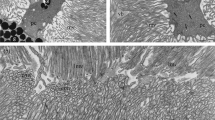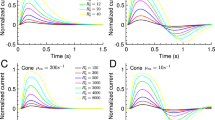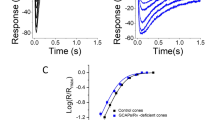Abstract
The light peak (LP) is a slow increase in the standing potential of the eye and has been attributed to a depolarization of the basal membrane of the retinal pigment epithelium (RPE). We tested effects of different external calcium ion concentrations ([Ca++]0) on the LP in the arterially perfused cat eye.
An increase in Ca++ activity by 3.2mM depressed the LP by 85–90% of its amplitude under control conditions. In contrast the other components of the light response (c-wave, fast oscillation, and second c-wave) did not change. The small increase in [Ca++]0 had insignificant effects on the amplitude-intensity plots of the a- and b-waves of the electroretinogram. Elevated [Ca++]0 had its effect only during onset of light and not after the LP was once initiated. The effects were reversible.
Since there is a very high [Ca++] concentration in the RPE cells and the pigment granulas may release Ca++ during illumination (Hess 1975), our results suggest that this ion plays a role during the initiation of the LP.
Similar content being viewed by others
References
Brown HM and Meech RW (1977) Light-induced changes of internal pH in a barnacle photoreceptor and the effect of internal pH on the receptor potential. J Physiol 297:73–93
Dawis S, Hofmann H and Niemeyer G (1985) The electroretinogram, standing potential, and light peak of the in vitro cat eye during acid-base changes. Vision Res. (in press)
Frankenhäuser B and Hodgkin AL (1957) The action of calcium on electrical properties of squid axons. J Physiol 137:218–244
Gouras P and Hoff M (1970) Retinal function in the isolated, perfused mammalian eye. Invest Ophthalmol 9:388–399
Gouras P, Chader G, Enriques N and Gibbons RC (1976) Calcium-induced spikes in cultured pigment epitheliums of chick retina. Invest Ophthalmol 15:62–64
Griff ER and Steinberg RH (1982) Origin of the light peak: in vitro study of Gekko gekko. J Physiol 331:637–652
Hagins WA (1972) The visual process: excitatory mechanisms in the primary receptor cells. Annu Rev Biophys Bioeng 1:131–158
Hess HH (1975) The high calcium content of retinal pigment epithelium. Exp Eye Res 21:471–479
Hofmann H (1984) The effects of calcium-ions on the light peak and the electroretinogram in the isolated, perfused cat eye. Invest Ophthalmol Vis Sci 25(3) Suppl: 289
Hofmann H (1985) Interaction between a normoxic and a hypoxic region of guinea pig and ferret papillary muscle. Circ. Research (in press)
Hubbell WL and Bownds DM (1979) Annu Rev Neurosci 2:17–34
Lipton SA, Ostroy SE and Dowling JE (1977) Electrical and adaptive properties of rod photoreceptors in Bufo marinus. J Gen Physiol 70:747–770
Lüttgau HC and Nidergerke R (1958) The antagonism between Ca and Na ions of the frog's heart. J Physiol 143:486–505
Meech RW and Thomas RC (1977) The effect of calcium injection on the intracellular sodium and pH of snail neurons. J Physiol 265:867–879
Meech RW (1976) Intracellular calcium and the control of membrane permeability. In: Calcium in biological systems. Symposia of the Society for Experimental Biology, vol 30: Cambridge, Cambridge University Press, pp 161–191
Niemeyer G (1975) The function of the retina in the perfused eye. Doc Ophthalmol 39:53–116
Niemeyer G (1981) Neurobiology of perfused mammalian eyes. J Neuroscience Methods 3:317–337
Niemeyer G (1983) Light modulation of the standing potential in the perfused mammalian eye: characteristics and responses to acidosis. Doc Ophthalmol Proc Ser 37:41–49
Nikara T, Sato S, Takamatsu T, Sato R and Mita R (1976) A new wave (second c-wave) on corneoretinal potential. Experientia 32:594–596
Reuter H (1976) The dependence of the slow inward current in Purkinje fibres on the extracellular calcium concentration. J Physiol 192:479–492
Rougier D, Garnier D, Gargouil YM and Coraboeuf E (1969) Existence and role of a slow inward current during the frog artrial action potential. Pflügers Arch Ges Physiol 308:91–110
Snyder WZ (1974) The effects of calcium and calcium-chelating agents on the aspartateisolated pIII response. Exp Eye Res 19:201–204
Winkler BS (1974) Calcium and the fast and slow components of PIII of the electroretinogram of the isolated rate retina. Vis Res 14:9–15
Yoshikami S and Hagins WA (1973) Control of the dark current in the vertebrate rods and cones. In: Biochemistry and physiology of visual pigments, ed: Langer H. Springer-Verlag, New York, 245–255
Yoshikami S, George JS and Hagins WA (1980) Light-induced calcium fluxes from outer segment layer of vertebrate retinas. Nature 286:395–398
Author information
Authors and Affiliations
Rights and permissions
About this article
Cite this article
Hofmann, H., Niemeyer, G. Calcium blocks selectively the EOG — light peak. Doc Ophthalmol 60, 361–368 (1985). https://doi.org/10.1007/BF00158925
Issue Date:
DOI: https://doi.org/10.1007/BF00158925




